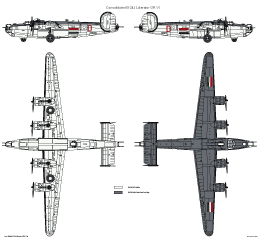Nederlandse Modelbouw en Luchtvaartsite
Dutch Modelling and Aviation
Consolidated B-24D & -J Liberator
History
In 1938, Consolidated Aircraft received the request to produce B-17s. The chief engineer, David Davis, however, came with its own wing design with a 15% reduction in air resistance. A rough draft was made of a four-engine aircraft with this wing.
The USAAC ordered in March 1939 the construction of a prototype of the Consolidated Model 32, USAAC designation XB-24. The aircraft with two tailfins had a unique construction of the bomb bay, which consisted of two parts, they rolled up like garage doors. The crew went through the bomb bay inside the aircraft. Equipped with four Pratt & Whitney R-1830-33 Twin Wasp engines of 1100 hp each unit had a maximum speed of around 440 km/hr. Furthermore, it was the first heavy bomber of the USAAF with a nose wheel undercarriage.
Even before the first flight was made Consolidated received an order to built seven test aircraft, designated YB-24. France also placed an order, which later went to the RAF.
Mid 1939 the USAAF ordered 120 units of the B-24, of which 20 examples were handed over to the RAF as Liberator I, which used them, equipped with radar and four 20mm cannons used in the nose , for anti submarine warfare.
Because the performance was disappointing, the XB-24 was ordered with four turbo-charged engines, Pratt & Whitney R-1830-43 of 1200 hp each, which gave the aircrfat, now designated XB-24B a top speed of nearly 500 km/hr. The XB-24B was equipped with self-sealing fuel tanks, and a larger span.
The stability and maneuverability of the B-24, would be improved with one vertical tail fin in place of the standard double tail. The B-24ST and XB-24K were equipped with a single fin and demonstrated this fact. The B-24N was the first version with a single tail that would enter production, but the order was canceled because of the end of the war. Only the B-24 derivative PB4Y Privateer went into production.
The B-24C was the first version in which the war experiences of the British were processed, though just nine examples were ordered which didn't enter operational service.
The first operationally deployable version was the B-24D, of which over 2700 were produced in a variety of sub-variants or production blocks.
In order to meet the demand for more firepower the B-24H was released with an Emerson A-15 nose turret and an improved tail and dorsal turret.
The B-24J appeared and was different from the B-24H especially the applied Convair A-6A nose turret, because the A-15 turret was not sufficiently available. Furthermore, the B-24J had an improved C-1 autopilot, new M-series bomb aim system, an improved fuel supply and an electronic control system of the turbo-superchargers.
The weight of the B-24 rose during development which had a negative impact on performance because the engines remained the same. A total of over 6600 examples of the B-24J were produced on all production lines.
Versions.
- XB-24:
- Prototype; first flight on December 29, 1939.
- YB-24:
- Pre production version. Seven examples built. six of them delivered to RAF as LB-30; The seventh aircraft was delivered to USAAC as 40-702.
- B-24:
- first production version; Ordered on April 27, 1939. One modified YB-24: added were de-icing boots; leading edge slots were omitted.
- B-24A/LB-30B:
- First real production version with improved aerodynamics. Nine examples were delivered to USAAF Ferrying Command and twenty examples were delivered to RAF as LB-30B .
- Liberator B Mk I: 20 examples. Proved to be unusable for operational use. Some were modified to GR.I and used for anti submarine patrol missions.
- XB-24B:
- one modified and improved XB-24 with four Pratt & Whitney R-1830-41 turbo-supercharged radial engines of 1200 hp each replacing the Pratt & Whitney R-1830-33 of 1000 hp. Top speed was about 60 km/hr higher. Because of the turbo-superchargers the cowlings were more oval in shape.
- B-24C:
- Negen examples of the production version of the XB-24B, equipped with a hydraulic Consolidated A-6 turret with two .50 machine guns; a Martin dorsal turret.
- Liberator B Mk II: 165 examples for RAF comparable with B-24C; First version suitable for operational use. Extended nose and enlarged fuselage and British equipment.
- B-24D:
- First version entering large scale production. Improved B-24C with four Pratt & Whitney R-1830-43 supercharged engines. Initially a ventral Bendix turret, because of problems later replace by a single .50 inch machine guns in a "tunnel". later also a Sperry turret was added.
The last series of the B-24D had two machine guns mounted under the nose.
2696 examples were built at several production lines.- XF-7: photo recce version of the B-24D.
- Liberator B Mk III: British version with .303 inch Browning machine guns, Boulton Paul tail turret and other British equipment. The Martin dorsal turret was maintained. 156 examples built.
- Liberator B Mk IIIA: Lend-Lease B-24Ds with US equipment and armament.
- Liberator B Mk V: B-24D version with enlarged fuel capacity and same armament as Liberator Mk III.
- Liberator GR Mk V: Modified B-24D for RAF Coastal Command for anti submarine warfare equipped with search radar and a search light.
- B-24ST:
- experimental version of B-24D with tail of a Douglas B-23 Dragon. This configuration proved to be more stable and more manageable.
- XB-24K:
- one modified B-24D, developed from B-24ST with tail of a Douglas C-54. Was further developed to PB4Y-2 and B-24N.
- B-24E:
- over 800 examples of a Ford bult version of the B-24D with Pratt & Whitney R-1830-65 engines and no ventral turret. Mainly used for training purposes.
- Liberator B Mk IV: never delivered RAF version of the B-24E.
- XB-24F:
- One modified B-24D for testing of thermal de-icing.
- B-24G:
- 25 examples of the North American built B-24S with a Sperry turret and three machine guns in the nose.
- B-24G-1: As B-25G but with a A-6 nose turret; 405 examples built
- B-24H:
- 3100 examples with heavier frontal armament; an electrical operated Emerson A-15 turret; strengthened airframe; modified tail turret and an Martin A-3 dorsal turret. The position of the side gunners had windows added.
- F-7: photo recce version of the B-24H.
- Liberator B Mk VI: RAF version with Boulton Paul tail turret, same armament as B-24H.
- B-24J:
- 6678 examples of a further improved version: the A-15 turret was replaced by a hydraulic Consolidated A-6 turret. Further an improved aut pilot and bomb aim installation was added.
- F-7A: photo recce version of the B-24J with three cameras in the nose and three ind the bomb bay.
- F-7B: Idem with six cameras in the bomb bay.
- Liberator B Mk VIII: RAF version to the B-24J.
- Liberator C Mk VI: transport version of the Liberator B Mk VIII.
- Liberator GR Mk VIII: Modified B-24J for RAF Coastal Command use for Anti submarine warfare.
- Liberator C Mk VIII: RAF modified transport version of the Liberator GR Mk VIII.
- Liberator GR Mk VI: RAF Coastal Command designation to the B-24G/H/J type for long distance patrol.
- B-24L:
- 1667 examples of a lighter version of the B-24J, in which the turret Sperry ventral turret was replaced by a ring arrangement with two machine-guns, and the A-6B tail turret replaced by a M-6A turret.
- RB-24L: trainer for B-29 air gunners with same armament as B-29.
- TB-24L: idem with added radar equipment.
- B-24M:
- 2593 examples of this last, further improved version van B-24L with further weight savings; a light weight version of the A-6B tail turret; open positions for the side gunners; re introduction of the Sperry ventral turret and, later a wind screen with less bars.
- XB-24N:
- re-design of B-24J with a single tail and an Emerson 128 turret in the nose and fixed tail guns, One example built.
- YB-24N:
- seven examples of the pre-production version of the XB-24N
- XB-24P:
- one modified B-24D for testing a fire extinguisher.
- XB-24Q:
- one General Electric modified B-24L with radar operated tail turret (as used in the Boeing B-47 Stratojet.
- XB-41:
- one modified B-24D with extra armament. To be used as an escort aircraft. The performance was very disappointing.
- C-87 Liberator Express:
- First transport version suitable for twenty passengers.
- AT-22 or TB-24: C-87 version for training of flight engineers.
- RY-2: U.S. Navy designation of the C-87.
- Liberator C Mk VII: RAF designation of the C-87.
- C-87A:
- VIP transport version with four R-1830-45 engines and and sleeping accommodation for sixteen passengers.
- RY-1: U.S. Navy designation of the C-87A.
- C-87B:
- Armed transport version. Not produced.
- PB4Y-1:
- 976 examples of the B-24D, B-24J, B-24L and B-24M for US Navy.
- PB4Y-1P: photo reconnaissance version.
- PB4Y-2 Privateer:
- version with enlarged single tail and other modifications.
- RY-3:transport version of the PB4Y-2.
- Liberator C Mk IX: RAF designation for RY-3/C-87C
- C-87C: USAAF designation for the RY-3.
- RY-3:transport version of the PB4Y-2.
- P5Y:
- Never built patrol version with two engines
| Dimensions: | |||
| Length: | 20,45 m | Wingspan: | 33,52 m |
| Height: | 5,46 m | Wing area: | 97,35 m2 |
| Weights: | |||
| Empty weight: | 16 780 kg | Max. start weight: | 28 123 kg |
| Performances: | |||
| Max. speed: | 434 km/hr | Cruising speed: | 382 km/hr |
| Range: | 3684 km | Service ceiling: | - m |
| Miscellaneous: | |||
| Engine type: | Four Pratt & Whitney R-1830-43 Twin Wasp rated 1200 hp each. | ||
| Crew: | Nine men | ||
| Armament: | About nine machine guns. Bombs. | ||
| Dimensions: | |||
| Length: | 20,45 m | Wingspan: | 33,52 m |
| Height: | 5,46 m | Wing area: | 97,35 m2 |
| Weights: | |||
| Empty weight: | 17 236 kg | Max. start weight: | 27 240 kg |
| Performances: | |||
| Max. speed: | 482 km/hr | Cruising speed: | 447 km/hr |
| Range: | 2465 km | Service ceiling: | - m |
| Miscellaneous: | |||
| Engine type: | Four Pratt & Whitney R-1830-65 Twin Wasp rated 1200 hp each. | ||
| Crew: | Eight men | ||
| Armament: | About ten machine guns. Bombs.. | ||
These aircraft were used at 321 squadron, RNlNAS and succeeded the old Catalina’s.
During 1942 the fresh crews educated at RNMFS, Jackson, requested more action than the rather passive patrols with the Catalina's. Admiral Helfrich agreed with this and tried to find a more offensive role for 321 squadron.
Because of the structure of the defence system this was not possible. 321 squadron was a maritime patrol unit, resorting under 222 General Reconnaissance Group, RAF India.
At the end of 1943 this structure was revised because of the changed situation and Air Command South East Asia was raised. The British would provide a unit with four engined bombers. They should receive about two thousand Liberators.
Because of the high demand for this bomber it took a long time to carry out the plans. In 1944 the Liberators were delivered to the British. After a lot of discussions in November 1944 at last permission was given to raise a Dutch Liberator unit.
Several crew were detached temporarily at No. 1673 Heavy Conversion Unit, Kolar and at 160 squadron RAF, Kankesanturai, Ceylon. Several surplus Catalina’s were returned to RAF. The first delivered (ex British) Liberators were in very poor condition. It took the technical crew a lot of work to get these aircraft in flying condition.
Twelve aircraft should delivered to the unit, but it took until May 1945 before seven new aircraft were sent by the British head quarters.
Now the training program could continue and in July six crew were completely trained. Squadron 321 was now assigned a new air base, at Cocos-islands. Its task was to prevent the Japanese navigation as much as possible.
During the night of 8 to July 9, 1945 the first three aircraft departed for the new base. Alas KH296/J crashed in sea just after take off, killing six of the crew. Fortunately five men could be saved. Some days later two other aircraft were flown to the Cosos Islands.
July 15, 1945 the first ‘anti shipping sweep’ was flown. Such flights were flown regularly until the Japanese capitulation on August 11, 1945. The last flight was at August 11, 1945.
The task of squadron 321 changed. Because of the situation in the prison camps the Liberators were used for supply in September 1945 and food en medicines were dropped.
In September 1945 a memorable flight was made with “Z”. Squadron leader OVL1 A.J. de Bruyn was allowed to fly the liberated Gouverneur-Generaal of Dutch East Indies, Jonkheer Mr. A.W.L Tjarda van Stakenborgh Stachouwer and the commander of the army General H. ter Poorter to the Netherlands.
They started in New Delhi and flew via Karachi, Caïro, Lydda, Istres and Hartfor Bridge to Eindhoven. October 8, 1945 they started to fly back to Dutch East Indies, but they were forced to stop at Colombo, because of the tumultuous situation at Batavia, the capital of the Dutch East Indies.
Despite the need for transport aircraft, the crew were set aside. Just in January 1946 the message was spread that the Liberators had te be returned to the RAF.
Because air base Perak was unsuitable for the large Liberator and air base Merauke was crowded with aircraft parked there, the aircraft could leave China Bay just in April 1946 to air base Morokrambangan. Liberator Y was left behind, and Liberators “A”, “B”, “M”, “P” and “W” were flown to Morokrembangan and were parked there until the end of May 1946, when these aircraft were handed over to the RAF.

Detachement of VSQ 321 on the Cocos isles, 1945.
[Enclosed photo from BeeldBank NIMH. Click on photo for ordering information]
[Enclosed photo from BeeldBank NIMH. Click on photo for ordering information]
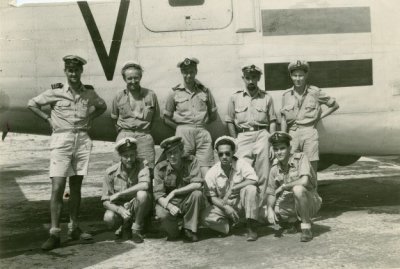
Detachement of VSQ 321 on the Cocos isles, 1945.
Crew of Liberator "V".
Standing from left to right: ltz H. Bosloper, kpl Faas, ltz (cdt) Höffelt, mjr Ferree, sgt Nieuwenhuizen.
Sitting: sgt H. van Donkelaar, sgt Visser, kpl Wijsheier, sgt Abbink
[Enclosed photo from BeeldBank NIMH. Click on photo for ordering information]
Crew of Liberator "V".
Standing from left to right: ltz H. Bosloper, kpl Faas, ltz (cdt) Höffelt, mjr Ferree, sgt Nieuwenhuizen.
Sitting: sgt H. van Donkelaar, sgt Visser, kpl Wijsheier, sgt Abbink
[Enclosed photo from BeeldBank NIMH. Click on photo for ordering information]

Marking on a `Consolidated B-24 Liberator 'Soerabaja Express', squadronn 321 RNlAS, based on Ceylon during 1942-1945
[Enclosed photo from BeeldBank NIMH. Click on photo for ordering information]
[Enclosed photo from BeeldBank NIMH. Click on photo for ordering information]

Consolidated B-24J Liberator Mk. GR VI of squadron 321 RNlAS based on Cocos Island
[Ingesloten foto van BeeldBank NIMH. Klik op de foto voor bestel-informatie]
[Ingesloten foto van BeeldBank NIMH. Klik op de foto voor bestel-informatie]
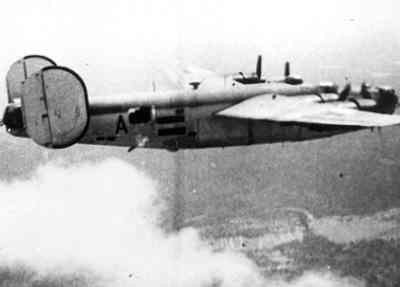
Consolidated B-24J Liberator Mk. GR VI of squadron 321 RNlAS flying over Ceylon
[Enclosed photo from BeeldBank NIMH. Click on photo for ordering information]
[Enclosed photo from BeeldBank NIMH. Click on photo for ordering information]

Consolidated B-24J Liberator Mk. GR VI of squadron 321 RNlAS, aircraft C on Ceylon
[Enclosed photo from BeeldBank NIMH. Click on photo for ordering information]
[Enclosed photo from BeeldBank NIMH. Click on photo for ordering information]
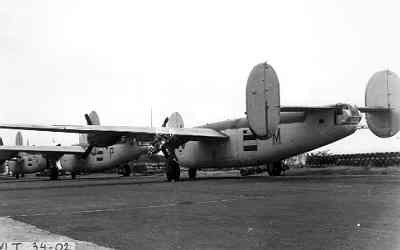
Consolidated B-24J Liberator Mk. GR VI, aircraft A, P and M on naval air station Morokrembangan,
[Enclosed photo from BeeldBank NIMH. Click on photo for ordering information]
[Enclosed photo from BeeldBank NIMH. Click on photo for ordering information]
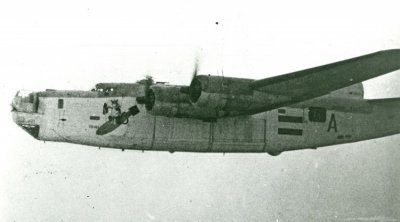
Consolidated B-24J Liberator Mk. GR VI of squadron 321 RNlAS flying over Ceylon
[Enclosed photo from BeeldBank NIMH. Click on photo for ordering information]
[Enclosed photo from BeeldBank NIMH. Click on photo for ordering information]
| RAF Serial | Fiscal-Year-nr. | Date entering service | Date out of service | Notes | |
|---|---|---|---|---|---|
| Loaned from RAF. Used by 321 squadron at China Bay for training purposes. It is unknown whether the aircraft had Dutch markings applied. Returned to RAF |
|||||
| FL912/P | 20-12-1944 | 25-02-1945 | FL912 | ||
| FL940/Z | 11-12-1944 | 16-02-1945 | FL940 | ||
| Serial / Code
Serial / Code
|
US Fiscal-Year-nr.
US Fiscal-Year-nr.
|
Date entering service
Date entering service
|
Date out of service
Date out of service
|
Notes
Notes
|
|
|---|---|---|---|---|---|
| Obtained from RAF, but because of bad condition returned RAF. | |||||
| EV824/L | 01-12-1944 | 27-05-1945 | |||
| EV831/N | 01-12-1944 | 27-05-1945 | |||
| EV832/M | 01-12-1944 | 27-05-1945 | |||
| EV869/I | 26-12-1944 | 27-05-1945 | |||
| EV889/G | 01-12-1944 | 27-05-1945 | |||
| EW321/E | 44-10324 | 01-02-1945 | 27-05-1945 | ||
| KG847/D | 44-10352 | 01-02-1945 | 27-05-1945 | ||
| Obtained from RAF. Used by 321 squadron at; China Bay, Cocos Island, and Dutch East Indies | |||||
| EV834/K | 01-12-1944 | 01-06-1945 | Returned RAF | ||
| EW317/F | 44-10320 | 20-12-1944 | 01-03-1946 | Returned RAF | |
| EW320/B | 44-10323 | 07-12-1944 | Scrapped, Naval Air Station Morokrembangan | ||
| KG852/A | 44-10357 | 26-12-1944 | 29-04-1905 | Scrapped, Naval Air Station Morokrembangan | |
| KG991/C | 44-10656 | 18-12-1944 | 26-12-1945 | Crashed near Seniarang; Written off. A sharkmouth was applied. | |
| KH138/W | 44-10703 | 01-05-1945 | 29-04-1946 | Scrapped, Naval Air Station Morokrembangan | |
| KH186/M | 44-10751 | 01-06-1945 | 18-06-1945 | Crashed and scrapped. | |
| KH187/H | 44-10752 | 01-05-1945 | 01-03-1946 | Returned RAF | |
| KH193/Y | 44-44054 | 01-05-1945 | 01-03-1946 | Returned RAF | |
| KH194/V | 44-44055 | 01-05-1945 | 01-03-1946 | Returned RAF | |
| KH296/J | 44-44167 | 01-05-1945 | 08-07-1945 | Crashed, China Bay. Written off. | |
| KH299/Z | 44-44170 | 01-05-1945 | Flew to the Netherlands in September 1945. Scrapped, Naval Air Station Morokrembangan | ||
| KH382/P | 44-44253 | 01-05-1945 | Scrapped, Naval Air Station Morokrembangan | ||
| KH383/M | 44-33254 | 01-06-1945 | Scrapped, Naval Air Station Morokrembangan | ||
1/72nd Scale
Kits
- Airfix
- Kit 05006-3 / 06010: A Model of a B-24J Liberator
- Hasegawa
- Kit 240E29: B24J Liberator (in the Netherlands available with Dutch Decals).
- Kit 2402114: F7A Liberator '20th Combat Mapping squadron".
- Kit 2402114: B24J Liberator "Assembly Ship".
- Kit 240E28: B24D Liberator
- Italeri
- Kit 1285: Consolidated B24D Liberator (Minicraft)
- Minicraft
- Kit 11640 / 11614 / 11665: Consolidated B24J Liberator
- Kit 11639 / 11612 / 11658: Consolidated B24D Liberator
- Kit 11633 / 11637: Consolidated PB4Y-1 Liberator
- Revell
- Kit H4430: Consolidated B24D Liberator
Modelling add-on
- AeroClub
- Kit P089: Hamilton Standard Hydro 11.6" (B17,B24,PB4Y,A20)
- AirWaves
- Kit AC72179: Convair B24 Liberator Detail set
- Eduard
- Kit E72-191: Detailset Consolidated B24J Liberator
- Kit E73-318 / SS318:Detailset B24J Liberator interior self adhesive (Hasegawa)
- Kit E72-489: Detailset B24 Liberator Bombbay (Hasegawa)
- Kit E72-492: Detailset B24J Liberator Exterior (Hasegawa)
- Kit big 7247: Detailset Consolidated B24J Liberator (Hasegawa)
- Kit E73-317 / SS317: Detailset B24D Liberator front interior self adhesive (Hasegawa)
- Kit E72-488:Detailset B24D Liberator Exterior (Hasegawa)
- Kit XS138: Express Mask Consolidated B24D Liberator (Academy)
- Kit big 7252: Detailset Consolidated B24D Liberator (Hasegawa)
- Falcon
- Kit VAX46: USAF Canopies Part 4
- Flightpath
- Kit 72024: B24H/J Liberator Detail Set
- Kit 72022: B24H/J Liberator Detail Set (Academy)
- High Planes Models
- Kit AC7210: PB4Y Privateer Engine Cowls
- Kit AC7209: B24 Liberator Engine Cowls
- Pavla
- Kit V7233: B24D Liberator Canopy and nose cone (Revell)
- Kit U72-40: Liberator GR MKV upgrade and conversion set
- QuickBoost
- Kit 72050: B24 Liberator engines (Academy)
- Scale Aircraft Conversions
- Kit 72009: B24 Liberator Landing Gear (Hasegawa)
- Squadron Signal
- Kit 09141: B24H/J (Cockpit Canopy,Nose Turret, Bomb. window)
- Kit 09142: B24H/J (Ball Turret,Upper Turrets,Tail Turret)
- Kit 09143: B24D (Cockpit Canopy,Nose Cone,Dorsal Turret,Tail)
- True Detail
- 72016: Consolidated B24/PB4Y Liberator/Privateer WheelSet
- Vector resin
- Kit 72004:Pratt & Whitney R1830
Decals
- Dutch Decal
- Set 72014: Set for several types of aircraft sich as Liberator Mk.GR.VI C/KG991: MLD
- KitsAtWar
- Set 7218: B24 Liberator (Kon Marine, RAF, RAAF) Mosquito (RAF)
1/48th Scale
Kits
- Revell
- Kit 04529: B-24D Liberator
- Monogram
- Kit 5608: B-24J Liberator
Modelling add-on
- Eduard
- Kit big4927: Detailset B24J Liberator (Monogram)
- Kit E48-634:Detailset Consolidated B24J Liberator Bomb bay (Monogram)
- Kit E48-647: Detailset Consolidated B24J Liberator surface panels (Monogram)
- Kit E48-618:Detailset Consolidated B24J Liberator Exterior (Monogram
- Kit E49-440: Detailset Consolidated B24J Liberator Front Interior - Self Adhesive (Monogram
- Kit E48-621: Detailset Consolidated B24J Liberator Rear Interior (Monogram)
- Kit E49-670: Detailset Consolidated B24J Liberator Seatbelts (Revell/Monogram)
- Kit E49-441 / FE441: Detailset Consolidated B24J Liberator Cockpit interior (Revell/Monogram)
- Kit E49-475: Detailset B24D Liberator Seatbelts (Revell/Monogram
- Kit FE474: Detailset B-24D Liberator cockpit interior Self adhesive (Monogram/revell kits
- Kit E48-636:Detailset Consolidated B24D Liberator Rear interior (Monogram)
- Kit E48-635: Detailset Consolidated B24D Liberator exterior (Monogram)
- Kit big4932: Detailset B24D Liberator (Revell/Monogram)
- Kit XF118:Express Mask B24 Liberator (Monogram)
- Falcon
- Kit VAX36: USAAF Canopies WW2 Part 2 (P38J/M, P51D, P40M, B24J, P51B, P40N)
- Flightpath
- Kit 48014: B24J Liberator Detail Set
- QuickBoost
- Kit 48048: Consolidated B24 Liberator Engines (Revell/Monogram)
- Scale Aircraft Conversions
- Kit 48093: B24 Liberator Landing gear (Monogram/ Revell)
- Squadron Signal
- Kit 09571 : Canopies Consolidated B24J Liberator (Main Canopy)
- Kit 09573: Canopies Convair B24 Liberator
- Kit 09588 : Canopies Convair B24D Liberato
- True Detail
- Kit 48024: Consolidated B24A-M Liberator Wheel Set
Decals
- --
- Set --: --
| Scheme | Colour name | FS number | BS number | Humbrol | XtraColor | Vallejo Model Color | Vallejo Model Air | Hataka | |
|---|---|---|---|---|---|---|---|---|---|
| Consolidated B-24D Liberator Mk.III: possibly with Dutch flags, but probably with English insigna and three tone camouflage pattern. | |||||||||
| RAF Standard #1 | Upper surfaces | Extra Dark Sea Grey | ~6099 | BS:640 | 123 / 106 | X005 / X376 | 70.866 | 71.110 | ~140 |
| Dark Slate Grey | 102 | X025 | 70.892 | 71.092 | ~202 | ||||
| Undersides | White | ~7875 | 130 | 70.820 | ~043 | ||||
| Consolidated B-24J Liberator GR.Mk.VII: Dutch flags applied to all aircraft | |||||||||
| RAF Standard #1 | Upper surfaces | Extra Dark Sea Grey | ~6099 | BS:640 | 123 / 106 | X005 / X376 | 70.866 | 71.110 | ~140 |
| Undersides | White | ~7875 | 130 | 70.820 | ~043 | ||||
Check www.paint4models.com for an extensive conversion table with lots of colour and paint systems.
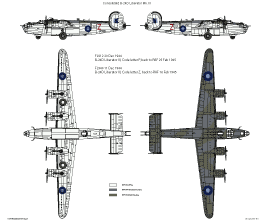
Consolidated B-24D Liberator MK. III.
Two examples of this type were used by the Dutch to convert to the Liberator. The aircraft kept (most problably) their RaF colur scheme and markings an received no Duthc marking.
Two examples of this type were used by the Dutch to convert to the Liberator. The aircraft kept (most problably) their RaF colur scheme and markings an received no Duthc marking.
Literature.
| Zestig jaar Marineluchtvaartdienst in Beeld. | Hugo Hooftman | Pag. 79 | 1977 | Uitgever Europese Bibliotheek, Zaltbommel |
| Dutch Military Aviation 1945-1978 | Paul A. Jackson | Pag. 123 | 1978 | Uitgever Midland Countries Publications, Leicester |
| Nederlandse Marinevliegtuigen | Thijs Postma & Nico Geldhof | Pag. 44 | 1978 | Uitgever Omniboek, 's Gravenhage |
| Aircraft Aerodata International No 11: Consolidated B-24 Liberator Early models | Philip J.R. Moyes | 1979 | Uitgever Vintage Aviation Publications Ltd., Oxford | |
| Profile 19: Consolidated B-24J Liberator | 1981 | Uitgever Profile Books Limited, Windsor, Berkshire | ||
| De geschiedenis van squadron 321: Nooit op de tweede plaats | Bart M. Rijnhout | pag. 29 - 30 | 1984 | Uitgever De Bataafsche Leeuw, Amsterdam |
| Aircraft Number 80: B-24 Liberator in action. | Larry Davis | Pag. 15 - 18; | 1998 | Uitgever Squadron/Signal Publications Inc., Carrolton, Texas |
| Vliegen voor de Vloot: 70 jaar Marineluchtvaartdienst | harm J. Hazewinkel | Pag. 34 | 1987 | Uitgever Rebo Produkties, Sassenheim |
| 70 Jaar Marine-LuchtvaartDienst | Nico Geldhof | pag. 92 -94 | 1987 | Uitgeverij Eisma b.v., Leeuwarden |
| 40 jaar Luchtvaart in Indië | G.Casius en T.Postma. | Pag. 118; 125-126 | 1988 | Uitg. De Alk, Alkmaar |
| Luchtvaart 5e jaargang nummer 1: No. 321 Squadron en de Liberator | N. Geldhof | Pag. 59 72; 86 92; 111 121. | 1988 | Uitg. Ten Brink Meppel |
| Vliegtuigsquadrons 320 en 321 50 jaar | P. Staal & Peter Baeten | pag. 44 - 47 | 1990 | Uitgever Afdeling Maritieme Historie, 's Gravenhage |
| Camouflage en Kentekens | J.Greuter e.a. | 1997 | Bonneville – Bergen (NH) | |
| 85 JAAR Marineluchtvaartdienst in beeld: Van Farman tot NH 90 Helikopter | Peter Korbee | Pag. 82 - 83 | 2002 | Uitgever Korbee MLD Promotie, Valkenburg |
Websites.
--

